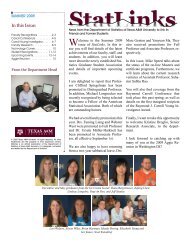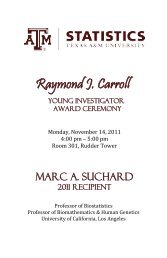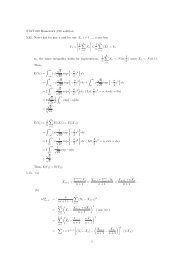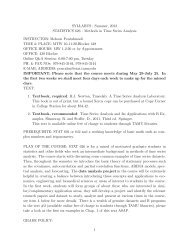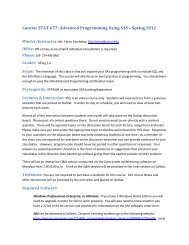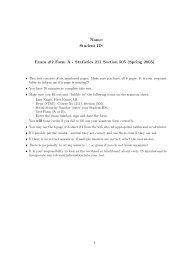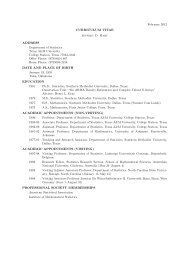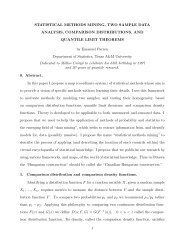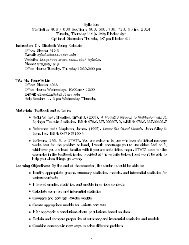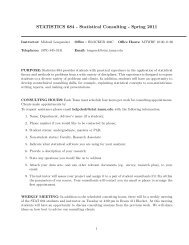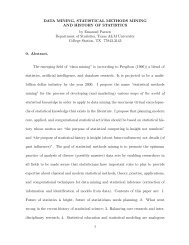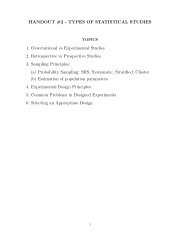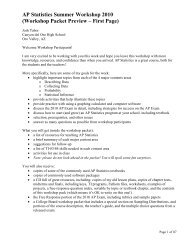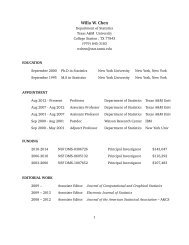STAT 689 Advanced Bayesian Modeling and Computation
STAT 689 Advanced Bayesian Modeling and Computation
STAT 689 Advanced Bayesian Modeling and Computation
You also want an ePaper? Increase the reach of your titles
YUMPU automatically turns print PDFs into web optimized ePapers that Google loves.
<strong>STAT</strong> <strong>689</strong> <strong>Advanced</strong> <strong>Bayesian</strong> <strong>Modeling</strong> <strong>and</strong> <strong>Computation</strong><br />
Instructor Bani Mallick<br />
Office 459B Blocker<br />
Phone 845-1275<br />
Office Hours 3-4, T/R<br />
Email bmallick@stat.tamu.edu<br />
TA Shubhankar Ray<br />
Office 459F Blocker<br />
Phone 458-0570<br />
Office Hours —<br />
Email sray@stat.tamu.edu<br />
Course website http://www.stat.tamu.edu/˜sray/stat<strong>689</strong>.html<br />
Prerequisites <strong>STAT</strong> 608, 613, 632 or approval of instructor.<br />
Description of course<br />
This is a research course intended for a mixed audience of graduate students in statistics <strong>and</strong> other<br />
fields who plan to use <strong>Bayesian</strong> methods in their own research. The topics covered will provide a<br />
broad exposure to the basic concepts, methodology <strong>and</strong> applications in Bioinformatics, Biostatistics,<br />
Signal Processing, Machine Learning <strong>and</strong> related areas. Students are required to work on a project<br />
with emphasis on h<strong>and</strong>s-on <strong>Bayesian</strong> computation in Matlab/BUGS; <strong>and</strong> present it at the semester<br />
end.<br />
References<br />
1. Gelman, Carlin, Stern <strong>and</strong> Rubin, <strong>Bayesian</strong> Data Analysis, CRC Press, 2003. 2. Denison,<br />
Holmes, Mallick <strong>and</strong> Smith, <strong>Bayesian</strong> methods for Nonlinear Classification <strong>and</strong> Regression, Wiley,<br />
2002. 3. Hastie, Tibshirani <strong>and</strong> Friedman, The Elements of Statistical Learning, Springer, 2001. 4.<br />
Bernardo <strong>and</strong> Smith, <strong>Bayesian</strong> Theory, Wiley, 1994.<br />
Course Outline*<br />
1. Hierarchical Models. Prior distributions, <strong>Bayesian</strong> Inference, Model assessment.<br />
2. <strong>Bayesian</strong> <strong>Computation</strong>. Asymptotic Methods, Non-iterative, Markov Chain, Sequential<br />
<strong>and</strong> Reversible Jump Monte Carlo methods.<br />
3. Model Criticism <strong>and</strong> Selection. Model Choice <strong>and</strong> Model Mixing.<br />
4. <strong>Bayesian</strong> Mixture Models <strong>and</strong> Variable Selection.<br />
5. <strong>Bayesian</strong> Classification <strong>and</strong> Regression. Linear <strong>and</strong> Non-linear Regression, Support<br />
Vector Machines, Partition Models, Classification <strong>and</strong> Regression Trees.<br />
6. Statistical Learning. Principal component analysis (PCA), Clustering, Kernel methods,<br />
Support Vector Machines.<br />
7. Spatial Models <strong>and</strong> Markov R<strong>and</strong>om Fields.<br />
1
8. Analysis of Functional Data.<br />
9. Applications. Bioinformatics (Microarray Data Analysis, Functional Genomics, Sequence<br />
Alignment, Hidden Markov Models, etc), Biostatistics (Survival Analysis, Longitudinal Analysis),<br />
Signal Processing, Spatial <strong>Modeling</strong>.<br />
* Course Material can be changed any time at the discretion of the instructor.<br />
Grading Policy<br />
The course grade will be based on some HWs (20<br />
Statement of Plagiarism<br />
As commonly defined, plagiarism consists of passing of as ones own ideas, words, writing, etc.,<br />
which belong to another. In accordance with this definition, you are committing plagiarism if you<br />
copy the work of another person <strong>and</strong> turn it in as your own, even if you should have the permission<br />
of that person. Plagiarism is one of the worst academic sins, for the plagiarist destroys the trust<br />
among colleagues without which research cannot be safely communicated. If you have any questions<br />
regarding plagiarism, please consult the latest issue of the Texas A&M University Student Rules,<br />
under the section Scholastic Dishonesty.<br />
Statement of Disabilities<br />
The Americans with Disabilities Act (ADA) is a federal anti-discrimination statute that provides<br />
comprehensive civil rights protection for persons with disabilities. Among other things, this legislation<br />
requires that all students with disabilities be guaranteed a learning environment that provides<br />
for reasonable accommodation for their disabilities. If you believe you have a disability requiring<br />
an accommodation, please contact the Offce of Support Services for Students with Disabilities in<br />
Room 126 of the Koldus Student Services Building. The phone number is 845-1637.<br />
Copyright Notice<br />
The h<strong>and</strong>outs used in this course are copyrighted. By h<strong>and</strong>outs, I mean all materials generated<br />
for this class including syllabi, exams, in-class material, <strong>and</strong> computer examples. Because these<br />
materials are copyrighted, you do not have the right to copy the h<strong>and</strong>outs, unless I expressly grant<br />
permission.<br />
2



